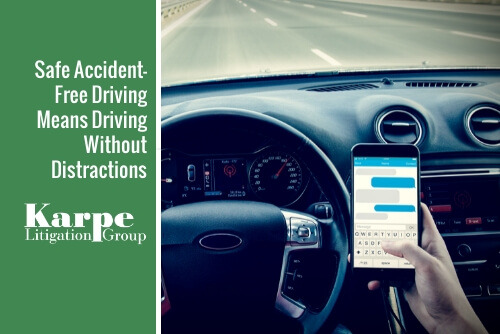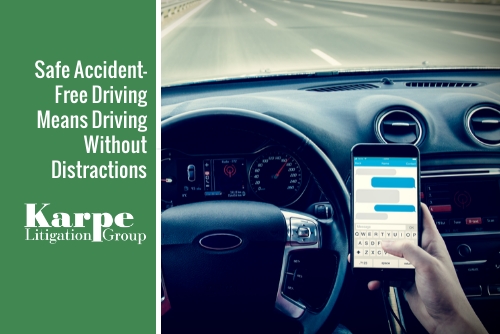
Every day in the United States, nine people are killed and 100 injured in accidents where the reported cause is distracted driving. To help raise awareness of this widespread danger on America’s roadways, government agencies have designated April as National Distracted Awareness Month.
What Defines Distracted Driving?
Distracted driving encompasses a variety of behaviors that generally fall into three main types:
- Visual - the driver takes their eyes off the road.
- Manual - the driver takes their hands off the wheel.
- Cognitive - the driver takes their mind off of driving.
Distracted driving can also be a combination of two or all three of these types. For example:
Texting - Incidents involving texting while driving are on the rise in the United States, despite efforts to raise public awareness of the issue. Taking your eyes off the road for just the few seconds it can take to look at a text is enough time to cause an accident. Obviously, the time it takes to type and send a text while driving is an even greater hazard. Taking your eyes off the road for just five seconds is enough time to travel the length of a football field at 55 miles per hour – without you even seeing where you’re going.
Talking on Phones - Along with texting, talking on cell phones is another area where the explosion of mobile technology is contributing to the rise of distracted driving. While hands-free models make it possible for drivers to keep their eyes on the road and their hands on the wheel, talking on phones still present a cognitive distraction, causing drivers take their minds off of driving.
Music - Playing music too loudly inhibits a driver’s ability to hear and respond to emergency vehicles and other audio cues that alert them to danger. This doesn’t mean you must drive a vehicle in silence. Keeping music at a volume where you can still hear sirens and respond accordingly can make the difference between reacting to a hazardous situation or causing one.
Passengers - When other people are in your car for the ride, it can place major demands on your attention. Turning to look at passengers when speaking to them takes your eyes off the road.
Eating - Eating and drinking any beverage while driving requires a person to take their hands off the wheel. This activity creates a dangerous situation because the driver is not fully in control of the vehicle.
Navigation Systems - Modern maps and GPS systems are very useful for drivers. However, the mapping information should be entered into the device or application before the car is in motion, rather than while driving is in progress.
Lost in Thought - The greatest percentage of distracted driving incidents resulting in death are caused by drivers who report they were “lost in thought” when the accident occurred. Drivers should remain aware of their actions, as well as the actions of other vehicles and pedestrians, at all times.
What National Distracted Driving Awareness Month Does
To raise awareness of the dangers of distracted driving, the U.S. Department of Transportation’s (USDOT) National Highway Traffic Safety Administration (NHTSA) designates April as National Distracted Driving Awareness Month, sponsored by the National Safety Council. Law enforcement officers nationwide are mobilized to look out for distracted driving behaviors, such as texting and talking on cell phones. The NHTSA partners with States and local police to enforce distracted driving laws, leading the fight to keep us safe.
The NHTSA and the National Safety Council mount awareness campaigns and public service announcements to help make drivers aware that safe driving means driving without distractions. They maintain a presence on social media platforms (Facebook and Twitter), sharing stories and driving tips to help save lives.
The key to the NHTSA’s efforts to educate the public on distracted driving and other risky driving efforts is their partnership with state and local police. The States determine various laws regarding driving safety that vary from State to State and the NHTSA provides Federal investments in locally-driven awareness campaigns and provides information for drivers to learn about the laws in their State.
The biggest NHTSA campaign is National Distracted Driving Awareness Month that occurs every April. During this time the NHTSA pairs nationally broadcast advertising with a locally driven crackdown called U text. U drive. U pay.
Join the Effort
Everyone can get involved in the fight against distracted driving and the effort to save lives. The National Highway Traffic Safety Administration states, “To prevent tragedies due to distracted driving, motorists are urged to:
- Turn off electronic devices and put them out of reach before starting to drive.
- Be good role models for young drivers and set a good example. Talk with your teens about responsible driving.
- Speak up when you are a passenger and your driver uses an electronic device while driving. Offer to make the call for the driver, so his or her full attention stays on the driving task.
- Always wear your seat belt. Seat belts are the best defense against unsafe drivers.”
Teens: Teen drivers are the best messengers when it comes to ending distracted driving. Teens are encouraged to speak up to their friends when they see distracted driving, to have their friends sign contracts saying they will not drive distracted and to get involved in their local chapter of Students Against Destructive Decisions (SADD). Formerly Students Against Driving Drunk, the organization encourages students to avoid making potentially destructive decisions to prevent driving accidents. Teens can share on social media to remind their friends and family about the dangers of distracted driving.
Parents: The best way for parents to contribute to teens developing safe driving behaviors is to lead by example. Parents should never exhibit distracted driving. Have everyone in the family sign a pledge to commit to distraction-free driving. Remind your teens if state laws dictate, distracted driving could lead to a delayed or suspended license.
Educators and Employers: Spread the word at your school and place of business about the importance of distraction-free driving. Ask your students to commit to distraction-free driving or set a company policy. Encourage employees to exhibit distraction-free driving at all times as a good example to fellow drivers and young people.
The National Safety Council provides materials for promoting National Distracted Driver Awareness Month, including free posters, videos, fact sheets and more to share at your school or business.
Personal Attention from Professional Attorneys
If you or someone you love has been harmed by a distracted driver, speak with the professional attorneys at Karpe Litigation Group today. We are experts in injury law, winning the most challenging cases and helping those in need for 20 years and counting. There is no fee until we win for you. Committed to making things easy for you, we are happy to meet by appointment on evenings and weekends, and travel to you when needed. Give us a call today at 1-888-228-7800 or fill out our contact form to schedule your free initial consultation.






